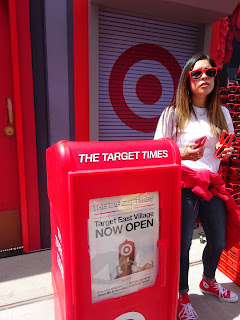Jane Jacobs is rolling in her grave today. The Target chain has opened a store on 14th Street and Avenue A, and for their grand celebration they have committed what might be the most deplorable commodification of local neighborhood culture I’ve ever witnessed.

Along the first floor of Extell’s luxury monster, known as EVGB for the Trumpian claim of “East Village’s Greatest Building,” Target has constructed a simulacrum of the hyper-local New York street--the sort of street that is being wiped out by corporations and developers--and it comes complete with all the signifiers.
The façade is draped in vinyl sheets printed with images of tenements, the same sort of buildings that get demolished to make room for such developments. Here they sit, hollow movie-set shells, below the shiny windows of the high-end rentals. They are the dead risen from the grave, zombies enlisted to work for the corporation.

A red newspaper kiosk announces the opening of the store with a fake newspaper (decorated with a bull’s-eyed water tower, as if hunters have it in their sights), and it brings to mind the lost kiosks of the vanished
Village Voice.
There’s even a fake fire hydrant and red-painted park benches.
In front of an Alphabet City bull’s-eye mural, you can pose for pictures with props—a guitar, a record album, a slice of pizza printed on foamcore--the stuff of the once iconoclastic East Village.

Who are the people in your neighborhood?
There’s a storefront gypsy telling fortunes with Target-branded Tarot cards.
And on a pseudo stoop is a hip-hop dancer, his leg encircled with a Target-branded bandanna. At his feet are red buckets, marked with the Target logo, maybe for someone to later play with drumsticks in the style popularized by bucket drummer
Larry Wright.

But worst of all, there’s a simulated CBGB, the celebrated punk club shuttered by a rent hike in 2006, replaced by the luxury John Varvatos store, and replicated in the Newark Airport as a theme restaurant for tourists.
This one boasts the famous awning, but it's printed with TRGT -- in the club’s iconic typeface, the western-style lettering created by owner Hilly Kristal’s ex-wife. (Restaurateur Daniel Boulud tried this in 2007 with DBGB on the Bowery, and the CBGB estate’s lawyer sent
a cease-and-desist letter.)
Inside, TRGT is printed on t-shirts, but you can't buy those. You can only get free "bands."

However, it's not rock music bands they’re giving out, it’s hair bands, Band-Aids, and resistance bands.
I asked, “What kind of resistance?” thinking of the political climate at the moment, and the woman answered, “They’re resistance bands for doing exercise.”

This Potemkin Village from Hell is guarded by three private security guards, all dressed in black suits with Secret Service-style earpieces, and one officer from the NYPD. All the workers are relentlessly sunny, like actors at Disneyland.
And people are streaming in for the free stuff—who doesn’t want free stuff?—happy to adorn themselves with the red sunglasses and branded bandannas as they rush into the store, where the commodification continues.
An East Village-themed mural provides a backdrop for the cash registers, decorated with street signs and hot dogs, more tenements, "NYC Nuyoricans," Theatre 80 St. Marks, and a book with the words “Poets Café.”
To see the artifacts of my own life, my cultural and spiritual awakening, my home, displayed above the cash registers in a Target store is to be cast into a state of confusion and dystopic dysphoria. What am I seeing? Who are these people? What happened to the world?


Meanwhile, down the block, EVGB has spray-painted the sidewalk with ads promoting their amenities and their worldview with the slogans:
GREATEST BUILDING
GROUP BONDING
GORGEOUS BATHROOMS
GET BUFF
GET BUSY
GO BIG

They’ve constructed a bright arc of balloons and they're giving out free cotton candy with "snappy toppings" like Pop Rocks, Sparkle, and Mango Pixie Dust.
Many of the people in line can't afford the apartments here, which start at $3,695 per month for a studio. They are neighborhood residents who've
lost a number of affordable local businesses to this development, places like the Stuyvesant Grocery, a laundromat, a hair salon, the Rainbow discount store, Bargain Express, and the Blarney Cove.
But today there is a bright and shiny simulation of the real and the local. There is cotton candy and free trinkets. Bread and circuses that appease--and even win over. And everyone is having a terrific time.
As Margaret Thatcher said, "Economics are the method; the object is to change the heart and soul."























